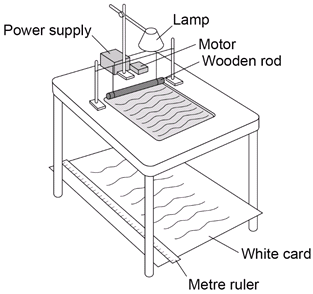Wave Equations
Frequency
The frequency of a wave is the number of waves that passes a given point in__ one second.__ It is measured in Hertz (Hz).
The equation for frequency is
Frequency = 1 / Time Period
f = 1 / T
Wave Speed
Measuring Wave Speed
Measuring wave speed in water
You are provided with the following:
• ripple tank plus accessories
• suitable low voltage power supply
• metre ruler
- Set up the ripple tank. A large sheet of white card or paper needs to be on the floor under the tank.
- Pour water to a depth of about 5 mm into the tank.
- Adjust the height of the wooden rod so that it just touches the surface of the water.
- Switch on both the overhead lamp and the electric motor.
- Adjust the speed __of the motor. __Low frequency water waves need to be produced.
- Adjust the height of the lamp. The pattern needs to be clearly seen on the card on the floor.
- Place a metre ruler at right angles to the waves shown in the pattern on the card.
- Measure across as many waves as possible. Then divide that length by the number of waves. This gives the __wavelength __of the waves.
- Count the number of waves passing a point in the pattern over a 10s.
- Then divide the number of waves counted by 10. This gives the frequency of the waves.
- Calculate the speed of the waves using the equation: wave speed = frequency x wavelength
Measuring wave speed in air
Method:
Although sound travels quite fast, it is still possible to measure its speed in air. To do this, you need to measure the time it takes a sound to travel a measured distance. To reduce errors, particularly timing errors, you should either:
- use a large distance (preferably over 50 metres), or
- use an electronic timer or data logger to record the time taken
Clap-echo method
This method involves measuring the time taken for you to hear an echo from a sharp clap. You stand a long distance from a wall, clap, and listen for the echo. The distance travelled is twice the distance from you to the wall (because the sound has to travel to the wall and back).
One way to reduce timing errors in this method is to clap in time to the echoes. This means that the time between each clap is the journey time for the sound. You then measure the time for 11 claps, which is the time for 10 journeys by the sound. This time can then be used to calculate an average time for the sound to travel to the wall and back.
Using microphones and data logger
A data logger can measure and record the time taken for sound to reach two microphones. Unlike the clap-echo method, these can be quite close together.
A ringing bell emits sound waves from left to right, towards two spaced microphones. The distance between them is d. The data logger will record the amount of time it takes between each microphone being activated. With the distance between the microphones and time take for each to activate we can use the equation Speed = distance / time to calculate the speed of sound in air.
- A water wave has a wavelength of 1m and a frequency of 2 Hz. How fast is the wave travelling?
- 2m/s
- A wave on a string is travelling at 3m/s. It has a wavelength of 3m. What is the frequency?
- 1Hz
- A flute gives out sound waves which travel at 330m/s and have of around 100Hz. What is the wavelength of this wave?
- 3.3m

